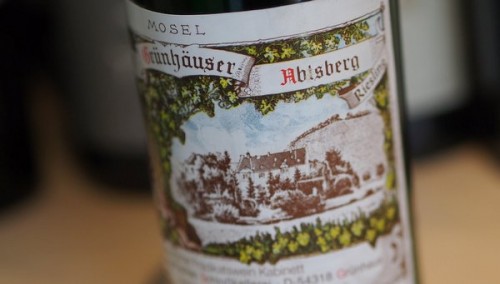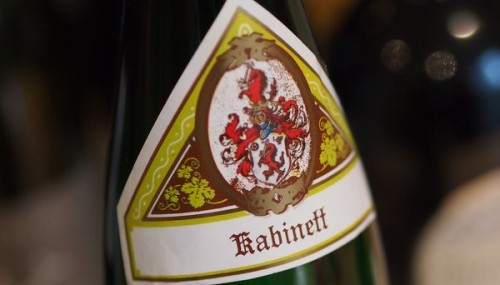
Just a few days ago I expressed my dissatisfaction with tasting notes, and their inability to capture the essence of the experience we have as we taste wine. So now I want to try to do better. I’m not sure I can, but I will attempt to express my experience in real time as I drink a wine.
I’ll begin with context. It’s 23:14 on July 23, and I have recently returned from a game of football, taken off my shinpads and socks, chilled a bottle down (rapidly, in the freezer), and now I am drinking it in the name of post-football rehydration. The house is beginning to quieten down. The dogs are asleep. My older son has his 19th birthday tomorrow and has two friends staying over, but they are in bed already as they have an early start in the morning.
The wine? It’s the Maximin Grünhäuser Abtsberg Kabinett Riesling 2011 from the Mosel. It’s the third bottle of a sixpack I bought en primeur a couple of years ago, and it wasn’t expensive.
Now we bring something to the wine drinking experience. Expectations, context and experience will all shape our perception. I admit that I am primed to like this wine. In part it is because I bought a six pack, so I’ve invested in it a bit. But it is also because it is a wine I have loved in previous vintages.
Indeed, a bit of research reveals that I have previously written an extended tasting note on this wine, from a trip to Japan back in 2003 (when I still had aproper job, as a science editor: we were holding a conference there). I also found my blog post from this visit (it’s here, you’ll need to scroll down to the September 28th entry). It was the evening I spent with this wine in Tsukuba that created a memory I carry with me, and which partly explains my ongoing affection for the Grunhaus Abs Kab, which is supplementary to the fact that it’s a really good wine. It was unexpected, and I found a beauty in the wine when I experienced it in this context.

So, I’m drinking the wine tonight. How do I find it? It’s quite beautiful, delicious, transparent and weightless. It is harmonious and fine.
It’s like the quality of the light on an autumn morning, where the fog is just clearing. A crisp morning with the promise of sunshine to come. There’s a brightness to this wine, but also some honeyed richness that speaks of later summer or autumn, rather than the spring that the citrus suggests.
At 9% alcohol, there’s a brightness and lightness to its body, and it is easy to drink.
Descriptors? If we were to do sensory analysis, then we would sit round a table and agree on which descriptors could apply to this wine, and we’d then analyse it, scoring it on various parameters. So I’m getting citrus, honey, melon, pear, toast, grape and dried herbs, with a big emphasis on the citrus and honey. In the mouth, it’s off-dry and nicely textured, with the sweetness giving some rounded characters. There’s a bit of spice on the finish, although ‘spice’ as a descriptor is notoriously imprecise.
There’s nice precision to the flavours. That is, there’s a beginning, a middle and an end to this wine. It can be separated out, in terms of its flavour, on a temporal dimension. It begins with the rich, sweet, citrussy aromas, there’s then a linear citrus kick in the mouth, and then it fills out in the middle with the sweetness and rounded richer fruit flavours. Finally, it finishes with a bit of pithy spicy detail that frames the sweet fruit very nicely.
When you drink wine, there’s an extra dimension to the experience that we often forget about. Wine contains alcohol, and as we drink we are changed by what we drink. There’s a real interaction here. We drink wine and it becomes part of us. It alters our thinking; it changes our perspective. Is wine really a virtuous intoxicant, as some have claimed? I think it may be. It’s interesting, because the taste of wine is based on an interaction between us and the wine, so if we are changed by the wine, then the wine’s taste will change as we drink it – often in subtle ways, but sometimes in more noticeable ways.
Another way to describe this wine: by comparison. So you have had a few Mosel Kabinetts? This is on the lighter side, in that it is a proper Kabinett and not a declassified Auslese. It is quite sweet, for sure, but it has freshness and a lightness of body. There’s purity here, with a focus on clean, ripe fruit. The acidity is appropriate. It is a well balanced, typical, high quality Kabinett.
It’s drinking very well now. It has developed a bit of weight and richness, but not too much, If you have some, you don’t need to drink it now, but it is the ideal time to start opening and drinking this wine. It will pick up weight and complexity over the next few years, but I will open my remaining bottles over the next 12 months because I think it is currently in a happy place.
The bottle is now finished. Mosel Riesling, with its lower alcohol, is just so drinkable. I’m not sure that I have managed to capture it all that well in my real-time tasting note, but I have tried.
4 Comments on Extended tasting note: Maximin Grunhaus Riesling Abtsberg Kabinett 2011
I am a Riesling lover too! Just lucky to live close the German border:)
I think this is a very good go at it.
I like the poetic stuff ‘autumn morning’ etc and i have always wondered at ‘precision’ which you explain very clearly.
The ‘extra dimension’ is new to me in a tasting note, it should be born in mind….if possible.
The timing is perfect and i am happy you finished the bottle!
Good work Jamie. I always enjoy tasting notes much more when they are contextualised (ie they’re written with the taster’s own situation/approach etc in mind).
Yep, very good effort. I also like the crisp autumn morning part.
I think we can draw parallels between known / shared experiences and aromas and flavours, in the way they make us feel. I often describe Rioja Reservas as autumnal and when someone asked me to explain I described a walk though a forest in October, all damp leaves and truffles and a kind of mellow earthy goodness and wood. Writing this here it seems easy to pick holes in it, as Riojas are not really earthy and damp leaves is dangerous territory for wine descriptors, but I know what I mean and I try and convey that. In the same way that you have conveyed the idea of freshness and ripeness with “A crisp morning with the promise of sunshine to come”. I think it can work well. Cold = fresh = acidity, Sunshine = golden warmth = ripeness.
The context you have put also adds an extra dimension and I think makes it easier for us to imagine. You’re thristy and tired after footie but it’s only 9% so you are able to enjoy a fair bit as a drink – it’s not just a clipped tasting note from a competition at 11am. You’re happy to enjoy it and it changes as the bottle goes down and the experience becomes more holistic.
Your expansion of the drinking window is useful and very clear and I like the way you tell us how you acquired the bottle and what it already meant for you before this example.
Great job, just a lot of work if you did it for every wine!